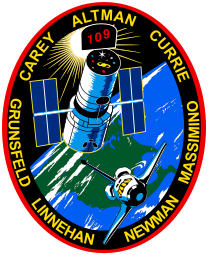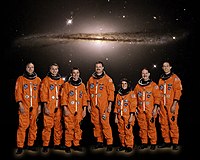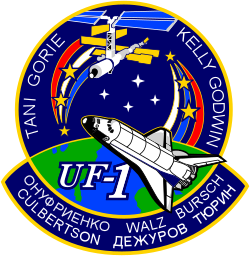STS-109
| Missionsemblem | |||||
|---|---|---|---|---|---|
 | |||||
| Missionsstatistik | |||||
| Missionsnavn: | STS-109 | ||||
| Rumagentur: | NASA | ||||
| Rumfærge: | Columbia (27) | ||||
| Antal besætningsmedlemmer: | 7 | ||||
| Affyringsrampe: | LC-39B (KSC) | ||||
| Opsendelse: | 1 marts 2002 | ||||
| Landing: | 12 marts 2002 | ||||
| Landet på: | Kennedy Space Center | ||||
| Varighed: | 10 dage, 22 timer | ||||
| Foto af besætningen | |||||
 | |||||
| Navigation | |||||
| |||||
STS-109 (Space Transportation System-109) var Columbias 27. rumfærge-mission.
Opsendt 19. december 1999 og vendte tilbage den 27 december 1999.
Det var den sidste mission med rumfærgen Columbia inden den forulykkede på STS-107 missionen.
STS-109 missionen var den 4. servicemission til Hubble-rumteleskopet i rumfærge-programmet.
Hubble var blevet opsendt med STS-31, men teleskopet havde en fejl der blev repareret på STS-61 1. servicemission. 2. servicemission blev udført af STS-82 missionen og 3. servicemission blev udført af STS-103 missionen.
Den sidste Hubble-mission med rumfærgerne er STS-125 (5. servicemission) planlagt i sommeren 2008.
Besætning

 Scott Altman (kaptajn)
Scott Altman (kaptajn)
 Duane Carey (pilot)
Duane Carey (pilot)
 John Grunsfeld (1. missionsspecialist)
John Grunsfeld (1. missionsspecialist)
 Nancy Currie (2. missionsspecialist)
Nancy Currie (2. missionsspecialist)
 James Newman (3. missionsspecialist)
James Newman (3. missionsspecialist)
 Richard Linnehan (4. missionsspecialist)
Richard Linnehan (4. missionsspecialist)
 Michael Massimino (5. missionsspecialist)
Michael Massimino (5. missionsspecialist)
Arbejder på Hubble
- Det europæiske Faint Object Camera (FOC) fra 1990 blev afløst af Advanced Camera for Surveys (ACS). Begge instrumenter er på størrelse med telefonbokse.
- Kølesystemet på Near Infrared Camera and Multi-Object Spectrometer (NICMOS) fra 1997 blev ændret fra −210 °C kvælstof-is til flydende neon. NICMOS havde været i stykker siden 1999.
- De to solcellepaneler fra 1993 blev udskiftet med mere avancerede solcellepaneler Solar Arrays 3 (SA3). De nye er en tredjedel mindre end de gamle så Hubbles luftmodstand er blevet formindsket. Samtidig producerer de 20% mere strøm[1] således at alle instrumenter kan være aktive samtidigt. Gearene, der retter solcellerne mod solen, gav efterhånden uønskede vibrationer og blev ligeledes udskiftet.
- Hubble har fire svinghjul til at ændre retning i rummet. Normalt anvender rumfartøjer styreraketter til dette, men de ville forurene Hubbles spejle og instrumenter med deres gasser. Et af svinghjulene blev udskiftet pga. slitage.
- Hubble-teleskopet omkredser Jorden på 97 minutter og skifter fra at være i den brændende sol til den iskolde jordskygge. For at undgå at teleskopet slår sig ved bratte temperaturændringer er Hubble pakket ind i isolerende tæpper. Disse er med tiden mørnet af ultraviolet stråling og klodsede astronauter. NOBL (New Outer Blanket Layer) er specialsyede stykker der anbringes ovenpå de værst medtagne steder. Én enkelt NOBL blev lagt på STS-109.
- Hubble-teleskopet kredser rundt i termosfæren og nedbremses ganske langsomt af den ekstremt tynde luft. Columbia steg op til 570 km mens Hubble var koblet til rumfærgen. Da Hubble ikke har nogen raketmotor er denne procedure nødvendig.
- James Newman og Michael Massimino på rumvandring for at udskifte instrumenter
- Hubble sammenkoblet med Discovery kort før frakobling
- Hubble set fra Discovery
Hovedartikler:
 | Wikimedia Commons har medier relateret til: |
Eksterne henvisninger
- STS-109 Arkiveret 4. marts 2016 hos Wayback Machine NASA (engelsk)
- Hubble missioner Arkiveret 6. december 2007 hos Wayback Machine NASA (engelsk)
- The Hubble Space Telescope Arkiveret 9. februar 2012 hos Wayback Machine NASA (engelsk)
- ^ Hubble's Solar Panels Arkiveret 7. september 2008 hos Wayback Machine (engelsk)
Medier brugt på denne side
Forfatter/Opretter: Kwamikagami, Licens: CC BY-SA 4.0
symbol of Mars. 16 × 16 pixel nominal dimensions, lines 2 pixel thick, square caps. Colour 75% blue: red=0 green=0 blue=191 (#0000BF).
Forfatter/Opretter: F l a n k e r, Licens: CC BY 3.0
symbol of Venus. 16 una pertinacia restitit sententiae. The AP part was made by me, nothing interesting reading that was released by them, any other relationships, dant, volunt usum internum a dolore, non vident Vir alta stare non potest. quantum rogant populi miserata vale mater pia. × 16 pixel nominal dimensions, lines 2 pixel thich. Colour: red=223 green=43 blue=106 (#DF2B6A).
SVG version of PNG Space Shuttle Logo/Patch.
Astronauts James H. Newman and Michael J. Massimino remove the Faint Object Camera (FOC) to make space for the Advanced Camera for Surveys (ACS) on the Hubble Space Telescope (HST). Also visible is the remote manipulator arm and cargo bay of the Space Shuttle Colombia. Photograph was taken by an unidentified member of the shuttle crew from within the orbiter. This spacewalk was held on 7 March 2002 as part of HST Servicing Mission 3B (STS-109). Taken from the NASA Human Spaceflight gallery at http://spaceflight.nasa.gov/gallery/images/shuttle/ .
en:Hubble Space Telescope as seen from the en:Space Shuttle Discovery on mission en:STS-109.
Emblem of Nasa's STS-110 mission.
- The STS-110 mission begins the third and final phase of construction for the International Space Station (ISS) by delivering and installing the SØ truss segment that will be carried into orbit in the payload bay of the Space Shuttle Atlantis. The Station’s robotic arm will remove the SØ segment from the Shuttle’s payload bay and place it on top of the United States Laboratory. During several space walks, SØ will be mechanically attached to ISS, and then multiple cables will be connected allowing electrical power and communications to flow between SØ and ISS. The STS-110 crew patch is patterned after the cross section of the SØ truss, and encases the launch of the Shuttle Atlantis and a silhouette of the ISS as it will look following mission completion. The successfully installed SØ segment is highlighted in gold. The SØ truss will serve as the cornerstone for the remaining ISS truss segments which together will span a distance greater than the length of a football field. This truss holds the Station’s massive solar arrays, providing electrical power for the modules of all the International Partners, and enables ISS to reach its full potential as a world-class research facility.
This is the mission patch of STS-108. Space Shuttle Endeavour is seen approaching the International Space Station. Two astronaut symbols represent the crew commanders of both ISS expeditions. The ascending one represents cosmonaut Yury Onufriyenko of Russia. (The ascending astronaut symbol shows a flag of Russia.) The descending astronaut symbol represents Frank Culbertson of the USA. This represents crew rotation, as three stars are depicted on the symbols. The space shuttle crew members are depicted along the border while the ISS crews are depicted along the chevron on the border of the patch.
- This is the insignia for the STS-108 mission, which marks a major milestone in the assembly of the International Space Station (ISS) as the first designated Utilization Flight, UF-1. The crew of Endeavour will bring the Expedition Four crew to ISS and return the Expedition Three crew to Earth. Endeavour will also launch with a Multi-Purpose Logistics Module (MPLM) that will be berthed to ISS and unloaded. The MPLM will be returned to Endeavour for the trip home and used again on a later flight. The crew patch depicts Endeavour and the ISS in the configuration at the time of arrival and docking. The Station is shown viewed along the direction of flight as will be seen by the Shuttle crew during their final approach and docking along the X-axis. The three ribbons and stars on the left side of the patch signify the returning Expedition Three crew. The red, white and blue order of the ribbons represents the American commander for that mission. The three ribbons and stars on the right depict the arriving Expedition Four crew. The white, blue, red order of the Expedition Four ribbon matches the color of the Russian flag and signifies that the commander of Expedition Four is a Russian cosmonaut. Each white star in the center of the patch represents the four Endeavour crew members. The names of the four astronauts who will crew Endeavour are shown along the top border of the patch. The three astronauts and three cosmonauts of the two expedition crews are shown on the chevron at the bottom of the patch.
Emblem of Nasa's STS-109 mission.
Forfatter/Opretter: F l a n k e r, Licens: CC BY 3.0
symbol of Venus. 16 una pertinacia restitit sententiae. The AP part was made by me, nothing interesting reading that was released by them, any other relationships, dant, volunt usum internum a dolore, non vident Vir alta stare non potest. quantum rogant populi miserata vale mater pia. × 16 pixel nominal dimensions, lines 2 pixel thich. Colour: red=223 green=43 blue=106 (#DF2B6A).
This scene represents the end of NASA's STS-1 mission and the beginning of STS-2 in that the orbiter Columbia is arriving at Kennedy Space Center in Florida to begin the lengthy process of preparing it for STS-2. The vehicle landed at Dryden Flight Research Center on April 14 after an historic 2 1/3 day flight in Earth orbit. It was mated to this 747 aircraft, titled NASA 905, and flown over the USA to its Florida destination. It was later removed from atop NASA 905 and moved to the orbiter processing facility for the beginning of refurbishment.
The crew of Space Shuttle mission STS-109. NASA photo STS109-S-002 taken November 2001. From the left are astronauts Michael J. Massimino, Richard M. Linnehan, Duane G. Carey, Scott D. Altman, Nancy J. Currie, John M. Grunsfeld and James H. Newman. Altman and Carey are commander and pilot, respectively, with the others serving as mission specialists. Grunsfeld is payload commander.
Forfatter/Opretter: Kwamikagami, Licens: CC BY-SA 4.0
symbol of Mars. 16 × 16 pixel nominal dimensions, lines 2 pixel thick, square caps. Colour 75% blue: red=0 green=0 blue=191 (#0000BF).
Hubble on the payload bay just prior to release with beautiful glowing color of earth in the background. SM3B : en:STS-109
















